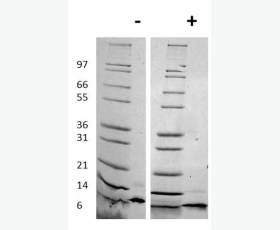Recombinant Human IL-1 Receptor Type 1/IL-1R-1
| Product name: | Recombinant Human IL-1 Receptor Type 1/IL-1R-1 |
| Source: | Human Cells |
| Purity: | Greater than 95% as determined by reducing SDS-PAGE. |
| Buffer Formulation: | Lyophilized from a 0.2 μm filtered solution of PBS, pH7.4. |
| Applications: | Applications:SDS-PAGE; WB; ELISA; IP. |
| Storage: | Avoid repeated freeze/thaw cycles. Store at 2-8 oC for one month. Aliquot and store at -80 oC for 12 months. |
| UOM: | 100ug/50ug/200ug/1mg/1g |
| Source | Human cells |
| Description | Recombinant Human Interleukin-1 receptor type 1/IL-1R-1 is produced by our Mammalian expression system and the target gene encoding Leu18-Thr332 is expressed fused with a Fc tag at the C-terminus. |
| Names | Interleukin-1 receptor type 1, IL-1R-1, IL-1RT-1, IL-1RT1, CD121 antigen-like family member A, Interleukin-1 receptor alpha, IL-1R-alpha, p80, CD121a |
| Accession # | P14778 |
| Formulation | Lyophilized from a 0.2 μm filtered solution of PBS, pH7.4. |
| Shipping |
The product is shipped at ambient temperature. |
| Reconstitution |
Always centrifuge tubes before opening. Do not mix by vortex or pipetting. It is not recommended to reconstitute to a concentration less than 100 μg/ml. Dissolve the lyophilized protein in ddH2O. Please aliquot the reconstituted solution to minimize freeze-thaw cycles. |
| Storage |
Lyophilized protein should be stored at < -20°C, though stable at room temperature for 3 weeks. Reconstituted protein solution can be stored at 4-7°C for 2-7 days. Aliquots of reconstituted samples are stable at < -20°C for 3 months. |
| Purity |
Greater than 95% as determined by reducing SDS-PAGE. |
| Endotoxin | Less than 0.1 ng/µg (1 IEU/µg) as determined by LAL test. |
| Amino Acid Sequence |
LEADKCKEREEKIILVSSANEIDVRPCPLNPNEHKGTITWYKDDSKTPVSTEQASRIHQHKEKLW FVPAKVEDSGHYYCVVRNSSYCLRIKISAKFVENEPNLCYNAQAIFKQKLPVAGDGGLVCPYMEF FKNENNELPKLQWYKDCKPLLLDNIHFSGVKDRLIVMNVAEKHRGNYTCHASYTYLGKQYPITRV IEFITLEENKPTRPVIVSPANETMEVDLGSQIQLICNVTGQLSDIAYWKWNGSVIDEDDPVLGED YYSVENPANKRRSTLITVLNISEIESRFYKHPFTCFAKNTHGIDAAYIQLIYPVTIEGRDMDPKS CDKTHTCPPCPAPELLGGPSVFLFPPKPKDTLMISRTPEVTCVVVDVSHEDPEVKFNWYVDGVEV HNAKTKPREEQYNSTYRVVSVLTVLHQDWLNGKEYKCKVSNKALPAPIEKTISKAKGQPREPQVY TLPPSRDELTKNQVSLTCLVKGFYPSDIAVEWESNGQPENNYKTTPPVLDSDGSFFLYSKLTVDK SRWQQGNVFSCSVMHEALHNHYTQKSLSLSPGK
|
| Background | Interleukin 1 receptor, type I (IL-1R1) is an interleukin receptor that belongs to the interleukin-1 receptor family. IL-1R1 is an 80 kDa transmembrane protein that is expressed predominantly by T cells, fibroblasts, and endothelial cells. This gene along with IL1R2, IL1RL2, and IL1RL1 form a cytokine receptor gene cluster in a region mapped to chromosome 2q12. IL-1R1 is an important mediator involved in many cytokine induced immune and inflammatory responses. It binds to interleukin-1 associates with the corecptor IL1RAP to form the high affinity interleukin-1 receptor complex which mediates interleukin-1-dependent activation of NF-kappa-B, MAPK and other pathways. The signaling involves the recruitment of adapter molecules such as TOLLIP, MYD88, and IRAK1 or IRAK2 via the respective TIR domains of the receptor/coreceptor subunits. It also binds ligands with comparable affinity and binding of antagonist IL1RN prevents association with IL1RAP to form a signaling complex. An IL1 receptor accessory protein that can heterodimerize with the Type I receptor in the presence of IL1α or IL1β but not IL1ra, was identified. Recombinant IL1 soluble receptor Type I is a potent antagonist of IL1 action. |














